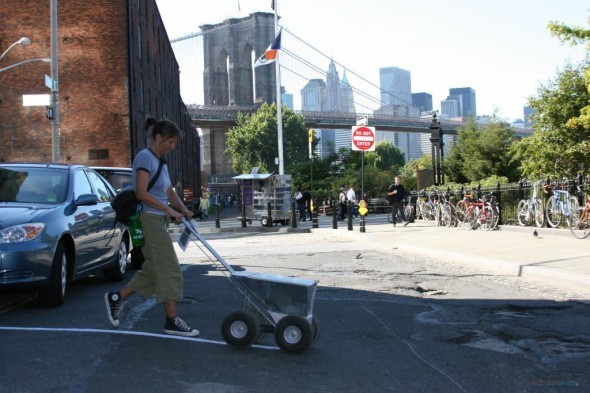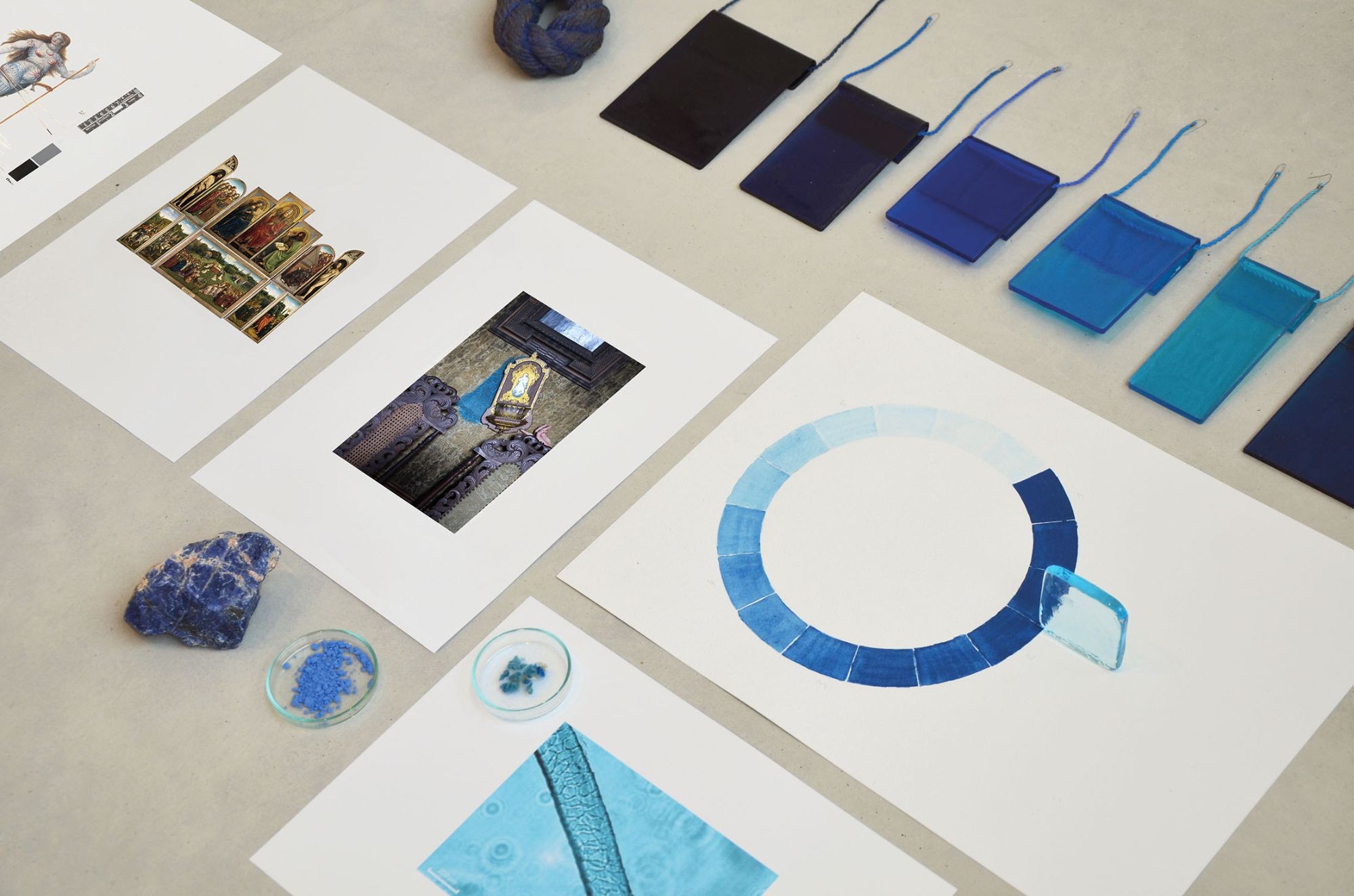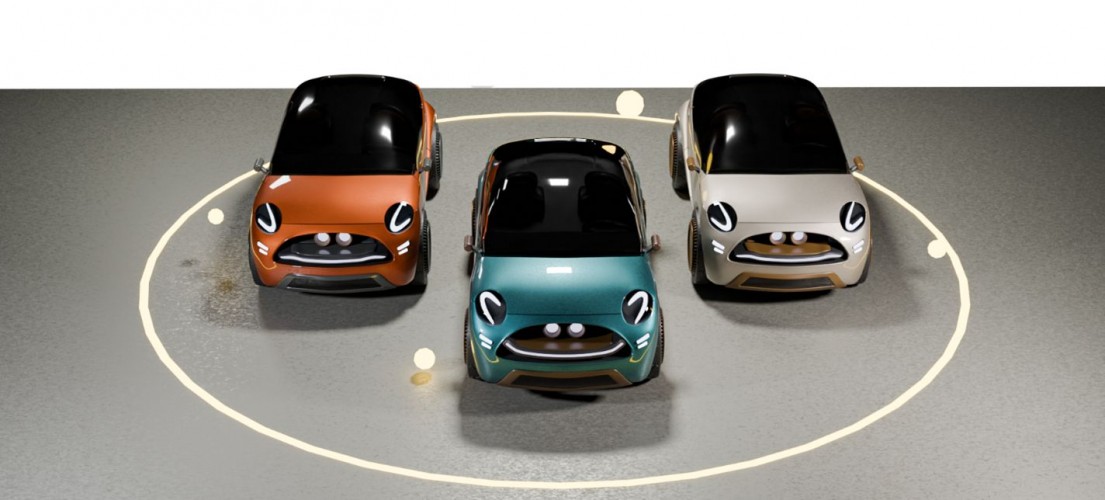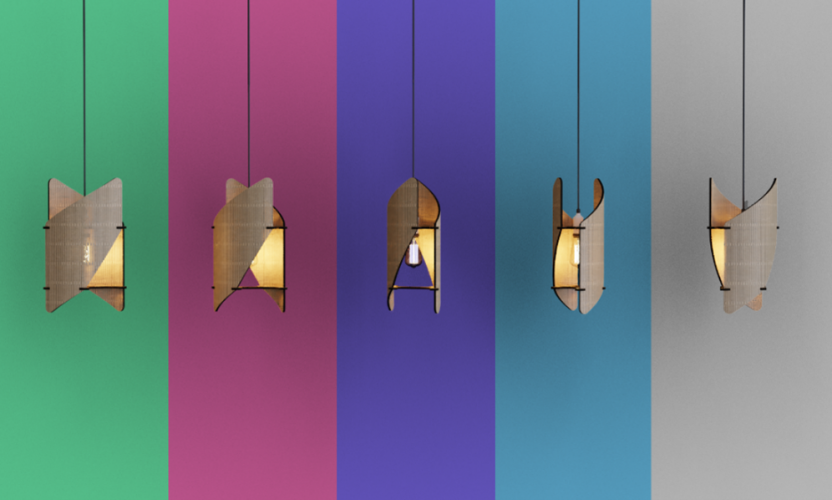Νερό: Έμπνευση και προειδοποίηση για την κλιματική αλλαγή στο design και την τέχνη.
DS.WRITER:
Σοφία Θρουβάλα
Κεντρική Εικόνα: Vitrum was commissioned by the Design Museum Ghent for the exhibition Kleureyck, Van Eyck's Colours in Design, 2020 | Πηγή εικόνας: studioplastique.be
Από πάντα το μπλε χρώμα ήταν ένα συμβολικό χρώμα. Πολύ πριν συνδεθεί με το νερό και την αειφορία, ζητήματα σύγχρονα και φλέγοντα, συνδέθηκε μέσω της τέχνης με τους μεγαλύτερους φόβους των ανθρώπων και αργότερα με το θείο και το δέος προς τη φύση. Στην Αίγυπτο ο Λαζουρίτης καλύπτει, μαζί με τη συνοδεία χρυσού, τα πρόσωπα των σπουδαιότερων Φαραώ. Οι αναφορές στην αρχαία Ελλάδα είναι ελάχιστες και έχει συνήθως κακές συνδηλώσεις, όπως του θανάτου και του κάτω κόσμου. Στα ύστερα ρωμαϊκά χρόνια, το μπλε παίρνει το όνομά του από τους βαρβάρους blavus, και μαζί με το όνομα συγκεντρώνει όλο τον φόβο για τον Βορρά και ό,τι προέρχεται από αυτόν. Ταυτόχρονα, στον δυτικό Μεσαίωνα ντύνει τους θόλους προσομοιάζοντας στον ουρανό, και μόλις τον 15ο αιώνα συνδέεται “γεωγραφικά” με τη θάλασσα και τους κινδύνους που επιφυλάσσει. Οι χάρτες της κεντρικής Ευρώπης αντικαθιστούν το πράσινο χρώμα που συμβόλιζε ως τότε τα υδάτινα σύνορα με το μπλε azurus, και αυτό θα συμβολίσει μια για πάντα το νερό! Αργότερα το μπλε θα συνδεθεί με τα blues και τα bluejeans, τα κινήματα απελευθέρωσης και τη χειραφέτηση, ενώ σήμερα αποτελεί το σύμβολο της τάξης, της “ασφάλειας” και της ενότητας, αφού οι σημαντικότεροι διεθνείς οργανισμοί αλλά και οι κρατικοί μηχανισμοί (όπως unesco, european union, european council, police και τα φιλελεύθερα ή/και δεξιά κόμματα) χρησιμοποιούν μπλε χρώμα στο logo τους, εμπιστευόμενοι την ψυχιατρική η οποία επιβεβαιώνει πως το χρώμα αυτό δημιουργεί συνθήκες ασφάλειας και οικειότητας σε αυτόν που το βλέπει.
Το χρώμα μπλε λοιπόν, ως σύγχρονο σύμβολο του νερού, είναι συνυφασμένο, τόσο ως χρώμα όσο κι ως στοιχείο, με πρακτικά ζητήματα όπως την οικονομία, την εθνική ταυτότητα, τις καταστάσεις κινδύνου, ζωής και θανάτου, καθώς και με την ταυτότητα γενικά, ενώ η σύγχρονη τέχνη και το design το χρησιμοποιούν προκειμένου να θίξουν εννοιολογικά και πρακτικά δύο από τα σημαντικότερα ζητήματα παγκόσμιας κλίμακας. Την κλιματική αλλαγή και τα Προσφυγικά ρεύματα. Η τέχνη έρχεται να γνωστοποιήσει και να προβληματίσει, και το design να προτείνει λύσεις που έχουν περισσότερο να κάνουν με τη βιωσιμότητα και τη χρήση του νερού ως νέα μορφή ενέργειας.
Η Hanna Ljungh, το 2010, συνέδεσε το νερό με τη βιωσιμότητα και πρότεινε τη χρήση του ως εναλλακτική πηγή ενέργειας με το έργο Civilize a Waterfall, υπονοώντας πως η λύση αυτή έχει ήδη αποκλειστεί λόγω της αύξησης της θερμοκρασίας. Αντίστοιχα, το 2013, ο Olafur Eliasson εξέθεσε στο ΜοΜΑ μερικά πραγματικά παγόβουνα, τα οποία αποκαλούσε γλυπτά. Τα 800 ετών κομμάτια πάγου είχαν αποκληθεί μόλις από τον παγετώνα της Ισλανδίας Vatnajokull. Το συγκλονιστικό έργο με τίτλο YOUR WASTE OF TIME εκτέθηκε σε ειδικά κλιματιζόμενη αίθουσα, η οποία λειτουργούσε σε θερμοκρασίες υπό του μηδενός, με τη χρήση ηλιακών συλλεκτών (panel).

Civilize a Waterfall | Πηγή αποσπάσματος/ εικόνας: vimeo.com
Η Eve Mosher, από το 2007 μέχρι και σήμερα, πραγματοποιεί το project με τίτλο Highwaterline. Η Mosher ενημερώνει για τις εξελίξεις της κλιματικής αλλαγής ζωγραφίζοντας με κιμωλία γραμμές στον δρόμο, ακριβώς 10 πόδια πάνω από τη στάθμη της θάλασσας, προκειμένου να δείξει τις περιοχές που θα βυθιστούν αν η υπερθέρμανση του πλανήτη δεν περιοριστεί ή οι περιοχές αυτές δεν λάβουν δραστικά μέσα. Το έργο ξεκίνησε από τον τυφώνα Κατρίνα το 2006, ένα από τα πρώτα κουδουνάκια της φύσης για αυτό που σήμερα βιώνουμε.

Olafur Eliasson, Your waste of time | Πηγή εικόνας: olafureliasson.net

Eva Mosher, Highwaterline, till now | Πηγή εικόνας: activate.zone
Στον χώρο του design, το 2017, μια ομάδα 13 σχεδιαστών εξέθεσε στο London Design Festival έργα τα οποία είχαν άμεση σχέση με το νερό. Η Kirsi Enkovaara δημιούργησε το Landscapes of Waters, παραπέμποντας στο νερό της Γης όπως αυτό φαίνεται χαρτογραφημένο από το διάστημα. Στόχος της έκθεσης ήταν να προωθηθεί το νερό ως ένα στοιχείο με ευεργετικές ιδιότητες, το οποίο συνδέεται όσο κανένα άλλο με τη ζωή στον πλανήτη. Τα κεραμικά της Enkovaara αποτελούν μια post-human χαρτογράφηση του νερού στον πλανήτη.

Landscapes of Water by Kirsi Enkovaara | Πηγή εικόνας: kirsienkovaara.com
Το 2019, η γκαλερί Nilufar παρουσίασε το συντριβάνι με τίτλο MetaFountain, της σειράς meta. Η σχεδιάστρια Audrey Large χρησιμοποιεί 3d printer για να δημιουργήσει γλυπτικές μορφές που παραπέμπουν σε συμπλέγματα σε συντριβάνια ιαπωνικών κήπων. Το χρώμα μπλε είναι το στοιχείο αυτό που κάνει τη σύνθεση να παραπέμπει στο νερό και να τοποθετεί το αντικείμενο σε μια πραγματικότητα με “ιστορικές” θα λέγαμε -αν και αόριστες- αναφορές. Η ίδια η σχεδιάστρια επιλέγει να αποκαλεί τα έργα της invisible objects, καθώς θεωρεί πως ακροβατούν μεταξύ ψηφιακού και υπαρκτού κόσμου. Στην περίπτωση αυτή, το νερό είναι που επαναφέρει το έργο σε μια επίγεια κατάσταση χρηστικότητας.

Nilufar, Audrey Large, METAFOUNTAIN | Πηγή εικόνας: nilufar.com/en
Το 2020, το studio plastique παρουσίασε την εγκατάσταση με τίτλο Vitrum. Μια εντυπωσιακή έκθεση αλλεπάλληλων φύλλων τζαμιού, βαμμένων σε μπλε αποχρώσεις. Η λέξη Vitrum είναι λατική λέξη και σημαίνει τόσο γυαλί όσο και indigo, δηλαδή μπλε. Στόχος των διαφανειών ήταν να εξεταστεί το πώς το φως περνάει και διαχέεται στον χώρο, προκαλώντας διαφορετικές αντανακλάσεις ανάλογα με την υφή της επιφάνειας του τζαμιού και τον τόνο του μπλε. Το πράσινο δασύ τοπίο έξω από τα παράθυρα του Schloss Hollenegg, του κτηρίου που φιλοξενούσε την έκθεση, χρησιμοποιήθηκε ως κάδρο για τη δημιουργία μιας γραμμικής αφήγησης, ως ωδή στις πιο παραδοσιακές μορφές παραγωγής χρωμάτων. Δηλαδή, στην παραγωγή χρώματος μέσα από την πρακτική επεξεργασίας φυτών. Αναλόγως την επεξεργασία δίνονται ξεχωριστά χρώματα και αποχρώσεις. Έτσι, γίνεται αναφορά στο πώς η ίδια η φύση παράγει μπλε δια μέσω του πράσινου (εδώ συμβολικό τοπίο Schloss Hollenegg) και πώς το μπλε μπορεί να ιδωθεί στη φύση και να θαυμαστεί υπό τις κατάλληλες φωτιστικές συνθήκες.

VITRUM | Πηγή εικόνας: studioplastique.be

Heleen Declercq | Πηγή εικόνας: studioplastique.be
Τέλος, πολύ πρόσφατα, τον Μάιο του 2021, ο οίκος μόδας Balenciaga άδειασε τις βιτρίνες του και στη θέση των ρούχων εγκατέστησε μονάχα το έργο τού Moreno Schweikle με τίτλο Spring Coolers. Τη βάση του γλυπτού αποτελεί ένας κλασικός ψύκτης, και στέψη αυτού μια μικρογραφία ενός μεγαλοπρεπούς συντριβανιού, στον ρόλο της “μπουκάλας”. Το έργο εμπνέεται από τα μεγάλα νεοκλασικά συντριβάνια των μητροπόλεων και την ευεργετική χρήση του νερού στα αστικά κέντρα. Η Balenciaga με την επιλογή του έργου επιθυμεί να προάγει το όραμα του Schweikle, δηλαδή την επιστροφή σε μια τέχνη και σε μια αρχιτεκτονική που εμπνέεται και καθοδηγείται από τις δημόσιες ιστορικές κρήνες που βρίσκονται στην Ευρώπη, ως μέρη συγκέντρωσης και συνδιαλλαγής του κόσμου με την τέχνη και τη φύση, εντός μιας καθημερινότητας που δεν δίνει την ευκαιρία για απόδραση.
.jpg)
Balenciaga, Moreno Schweikle, Spring Coolers, 2021 | Πηγή εικόνας: ANNIK WETTER
ΠΗΓΕΣ:
https://studioplastique.be/vitrum.html
https://www.frameweb.com/article/balenciaga-art-in-stores-moreno-schwiekle
https://nilufar.com/en/product/metafountain-audrey-large-6079-6088
https://www.dezeen.com/2017/09/24/13-ways-with-water-exhibition-london-design-festival
https://activate.zone/the-politics-of-water-and-contemporary-art
https://press.princeton.edu/books/hardcover/9780691181363/blue








